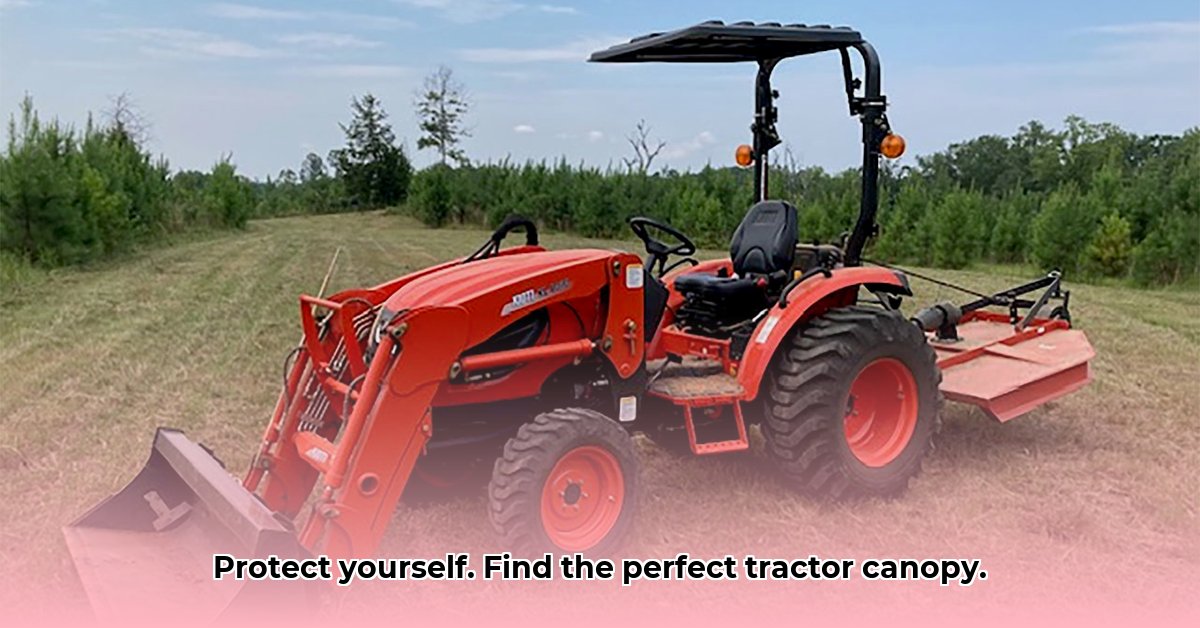
Protecting yourself while operating a tractor is crucial, and a Rollover Protective Structure (ROPS) canopy is a vital component of that protection. For more options, check out this helpful resource. This guide simplifies the process of selecting the ideal canopy, balancing safety, budget, and environmental responsibility.
Choosing the Right Tractor Canopy: Metal vs. Plastic
The choice between metal and plastic canopies involves weighing several factors. Both offer advantages and disadvantages, demanding careful consideration of your individual needs and priorities.
Metal Canopies: Durability and Strength
Metal canopies are known for their robust construction, offering superior protection in accidents. Their inherent strength ensures longevity, often outlasting plastic counterparts. This durability translates to a longer return on investment. However, metal canopies are typically heavier, more expensive, and susceptible to rust and corrosion without proper maintenance. Their manufacturing process also often has a larger environmental footprint than plastic alternatives. Do you prioritize long-term durability above all else?
Plastic Canopies: Lightweight and Budget-Friendly
Plastic canopies, frequently made from polycarbonate or similar materials, offer a lighter and more affordable alternative. They are generally resistant to rust and corrosion, simplifying maintenance. Some manufacturers are increasingly using recycled plastics, offering a more sustainable choice. However, while robust, they may not match the impact resistance of metal canopies. Prolonged sun exposure can degrade the plastic, reducing its lifespan and strength. Are cost-effectiveness and lower maintenance your top considerations?
Essential Safety Features: Prioritizing Protection
Regardless of material, several safety features are paramount:
- Compliance with Safety Standards: Ensure your chosen canopy meets or exceeds all relevant safety regulations in your region. This is non-negotiable for ensuring adequate protection.
- Unimpeded Visibility: The canopy's design mustn't obstruct your view. Optimal visibility is critical for safe operation, especially in challenging conditions or low-light situations. How important is unobstructed visibility to your work?
- Secure Mounting System: The canopy's attachment to the ROPS must be secure and robust. A poorly secured canopy poses a significant risk. What measures will you take to guarantee a secure installation?
- Durable Construction Materials: Select a canopy made from high-quality materials designed to withstand impacts and harsh weather. Consider the climate challenges you face regularly.
- Convenient Access: Easy access to and from the tractor is crucial for both safety and efficiency. Does the canopy design allow for quick and easy entry and exit?
Installation and Maintenance: A Step-by-Step Guide
Proper installation and ongoing maintenance significantly impact your canopy's longevity. Always refer to your manufacturer's instructions. However, these general steps provide a useful framework:
- Thorough Inspection: Before starting, carefully examine both the ROPS and the canopy for any pre-existing damage. Don't proceed if any issues are detected.
- Precise Alignment: Ensure perfect alignment between the canopy and the ROPS mounting points. Imprecise alignment compromises safety and stability.
- Secure Fastening: Use the correct fasteners and tighten them firmly. Never compromise on securing connections.
- Post-Installation Check: After installation, meticulously verify every connection's security.
- Regular Inspection and Maintenance: Periodically inspect for wear and tear. Tighten loose bolts and address any damage promptly. Regular cleaning extends the canopy's lifespan.
Sustainability in Canopy Selection: Eco-Conscious Choices
Environmental responsibility is increasingly important. Consider these factors:
- Recycled Content: Prioritize canopies utilizing recycled materials, reducing the demand for new resources.
- Recyclability: Choose canopies made from recyclable materials, minimizing landfill waste at the end of their lifespan.
- Manufacturing Practices: Inquire about the manufacturer's commitment to environmentally sustainable production methods.
Current Market Trends and Future Innovations
The tractor canopy market is dynamic. Key trends include:
- Advanced Materials: Innovations continually yield lighter, stronger, and more durable materials.
- Ergonomic Designs: Manufacturers are prioritizing designs enhancing operator comfort and reducing fatigue.
- Sustainable Manufacturing: The industry is increasingly focused on sustainable production and responsible sourcing of materials.
Buying Guide: A Checklist for Informed Decision-Making
This checklist helps prioritize key factors:
| Factor | Considerations |
|---|---|
| Budget | Balance upfront cost with long-term value and maintenance considerations. |
| Tractor Compatibility | Ensure complete compatibility with your tractor model and ROPS system. |
| Material | Weigh the pros and cons of metal (durability) and plastic (cost, recyclability). |
| Safety Features | Prioritize visibility, secure mounting, and easy access. |
| Installation Ease | Consider your installation capabilities and whether professional assistance is needed. |
| Sustainability | Evaluate the manufacturer's commitment to sustainable materials and processes. |
Investing in the right tractor canopy is a critical decision affecting both safety and productivity. By carefully weighing the factors presented here, you can choose the canopy that best meets your needs and contributes to a safer, more sustainable farming operation.